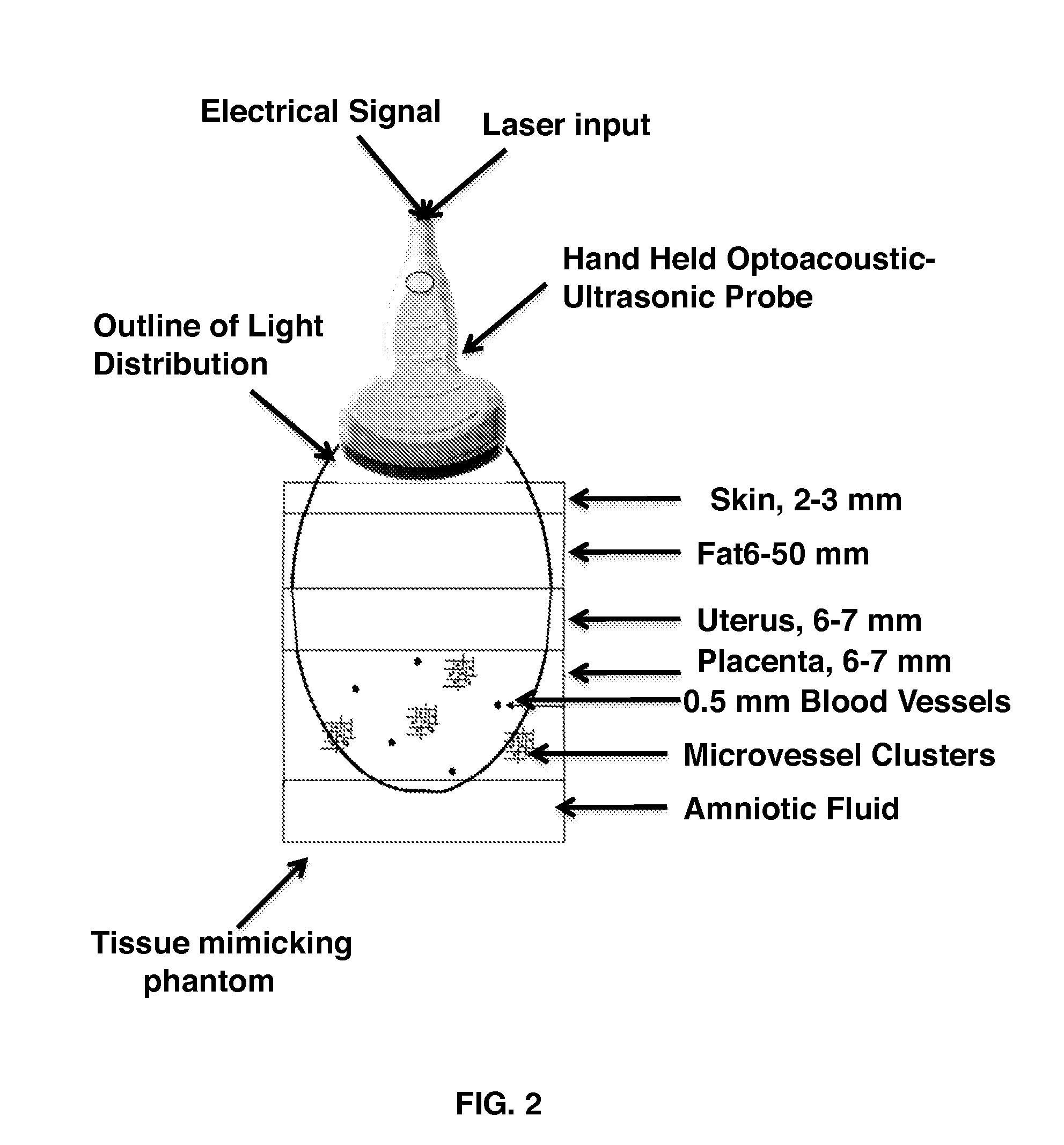Optoacoustic-Ultrasonic System for Coregistered Functional and Morphological Imaging of Placentas
a technology of optical and morphological imaging and co-registration, applied in the field of biomedical imaging and obstetrics, can solve the problems of inability to estimate local placental perfusion, inability to measure tissue oxygenation, and limitations of those approaches
- Summary
- Abstract
- Description
- Claims
- Application Information
AI Technical Summary
Benefits of technology
Problems solved by technology
Method used
Image
Examples
example 1
LOUIS Imaging System
[0045]FIG. 1 illustrates the LOUIS imaging system which is configured or enabled for high resolution real-time optoacoustic imaging of intra- and extraplacental blood perfusion, for high resolution real-time optoacoustic imaging of placental blood and oxygenation and for mapping the functional information of perfusion and oxygenation onto the morphological structures that is visualized concurrently using transabdominal or transvaginal ultrasound. More particularly, the figure illustrates:
[0046]1) an ultrasonic probe upgraded with light delivery system;
[0047]2) OAT Data Acquisition Board (DAB) and software that works either in “sequence” mode or in a “toggling” acquisition mode with ultrasound; and
[0048]3) an additional laser unit that provides Q-switched fiber optically coupled output in a near infrared optical range or spectral window of about 750-840 nm.
example 2
Digital Phantoms for Computer Simulations of Transabdominal Optoacoustic Imaging of Placenta
[0049]Digital phantoms are utilized for Monte Carlo based simulations of OAT imaging. A typical digital OAT phantom is a 3D map of optical properties which simulates a portion of the body affected by illumination during an OAT imaging procedure. Special care is taken with respect to boundary conditions by accounting for optical continuity of deep tissues and by modeling physical contact of the skin and optoacoustic probe. The digital phantoms utilized herein have a stratified geometry with individual layers representing skin, adipose tissue, uterus, placenta, and amniotic fluid (FIG. 2). The thickness of each layer is either obtained from published reference data or is estimated from at least 10 transabdominal ultrasonic images acquired during routine clinical examinations of the placenta at various gestational ages.
[0050]Each layer, except for the placenta, is represented as a homogeneous me...
example 3
Optimization of Shape, Size, and Arrangement of the Optical Fibers within Standard Transabdominal Ultrasound Probe Using Monte Carlo Computer Simulation of Optoacoustic Imaging and Digital Phantom
[0052]Optical illumination is critical for good quality 2D or 3D optoacoustic imaging. Conventionally it is achieved using two fiber optic bundles shaped at the output termini in a rectangular pattern and attached on both sides of the ultrasound probe (FIG. 3). Two illumination modes, dark field and bright field, have been employed currently for 2D OAT imaging. Dark field is formed when light bars are significantly separated from the imaging plane of the probe. In that case OAT image is formed by backscattered light. Such an approach significantly limits the depth of view and is not practical for imaging tissue that is deeper than 1 cm. The bright field mode is formed by forward scattered photons. It is traditionally used in clinical applications for 2D OAT imaging of breast and prostate (1...
PUM
 Login to View More
Login to View More Abstract
Description
Claims
Application Information
 Login to View More
Login to View More - R&D
- Intellectual Property
- Life Sciences
- Materials
- Tech Scout
- Unparalleled Data Quality
- Higher Quality Content
- 60% Fewer Hallucinations
Browse by: Latest US Patents, China's latest patents, Technical Efficacy Thesaurus, Application Domain, Technology Topic, Popular Technical Reports.
© 2025 PatSnap. All rights reserved.Legal|Privacy policy|Modern Slavery Act Transparency Statement|Sitemap|About US| Contact US: help@patsnap.com



